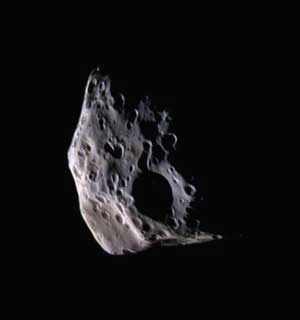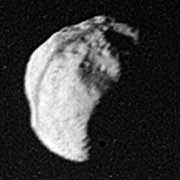|
|
Epimetheus (ep'-i-mee'-thee-us, Greek Επιμηθεύς) is a moon of Saturn. It is also known as Saturn XI. It is named after the mythological Epimetheus. Discovery Epimetheus occupies essentially the same orbit as the moon Janus. Astronomers assumed that there was only one body in that orbit, and accordingly had a hard time figuring out their orbital characteristics; it is obviously impossible to reconcile the observations of two distinct objects as a single object. Audouin Dollfus observed a moon on December 15, 1966, which he proposed to be named "Janus"[3]. On December 18, Richard L. Walker made a similar observation which is now credited as the discovery of Epimetheus[4]. However, at the time, it was believed that there was only one moon, unofficially known as "Janus", in the given orbit. Twelve years later, in October 1978, Stephen M. Larson and John W. Fountain realised that the 1966 observations were best explained by two distinct objects (Janus and Epimetheus) sharing very similar orbits. This was confirmed in 1980 by Voyager 1, and so Walker officially shares the discovery of Epimetheus with Larson and Fountain. The 1980 Voyager discovery was designated S/1980 S 3, and it was officially named "Epimetheus" in 1983. The name Janus was officially approved by the IAU at the same time, although the name had been used informally since Dollfus proposed it a few days after the 1966 discovery.
Orbital relationship between Epimetheus and Janus Epimetheus and Janus are "co-orbital". Janus' orbital radius from Saturn is 151,472 km and Epimetheus' orbital radius is 151,422 km, a separation of only 50 km. Since closer orbits have higher velocities the two moons must inevitably approach each other, and since Epimetheus' diameter is 115 km and Janus' is 178 km it would seem at first glance that a collision is also inevitable. But as the inner moon catches up with the outer moon their mutual gravitational attraction boosts the inner moon's momentum and raises its orbit, causing it to slow down. The outer moon loses an equal amount of momentum and drops into a lower orbit at the same time, speeding it up. The moons thus "trade" orbits and begin moving apart again, without actually approaching each other closely. The exchange takes place about once every four years; the next closest approach is in Jan/Feb 2006. This arrangement is unique in the solar system, as far as is currently known. Other unusual orbits include the retrograde orbit of Triton around Neptune, and the "horse-shoe" orbit of Cruithne and (potentially) dozens of other objects in similar orbits [5].
Physical characteristics Epimetheus, as imaged by Voyager 1 (NASA) There are several Epimethean craters larger than 30 km in diameter, as well as both large and small ridges and grooves. The extensive cratering indicates that Epimetheus must be quite old. Janus and Epimetheus may have formed from a disruption of a single parent to form co-orbital satellites, but if this is the case the disruption must have happened early in the history of the satellite system. From its very low density and relatively high albedo, it seems likely that Epimetheus is a very porous icy body. There is a lot of uncertainty in these values, however, and so this remains to be confirmed. The Cassini orbiter is due to perform a flyby of Epimetheus on December 3, 2007.
See also List of geological features on Saturn's smaller moons Links The Planetary Society: Epimetheus ... | Pandora | Janus, Epimetheus | Mimas | ... Saturn's natural satellites
Pan | Daphnis | Atlas | Prometheus | S/2004 S 6 | S/2004 S 4 | S/2004 S 3 | Pandora | Epimetheus and Janus | Mimas | Methone | Pallene | Enceladus | Telesto, Tethys, and Calypso | Polydeuces, Dione, and Helene | Rhea | Titan | Hyperion | Iapetus | Kiviuq | Ijiraq | Phoebe | Paaliaq | Skathi | Albiorix | S/2004 S 11 | Erriapo | Siarnaq | S/2004 S 13 | Tarvos | Mundilfari | S/2004 S 17 | Narvi | S/2004 S 15 | S/2004 S 10 | Suttungr | S/2004 S 12 | S/2004 S 18 | S/2004 S 9 | S/2004 S 14 | S/2004 S 7 | Thrymr | S/2004 S 16 | Ymir | S/2004 S 8 see also: Rings of Saturn | Cassini-Huygens | Themis Images
Retrieved from "http://en.wikipedia.org/"
|
|
|||||||||||||||||||||||||||||||||||||||||||||||||||||||||

